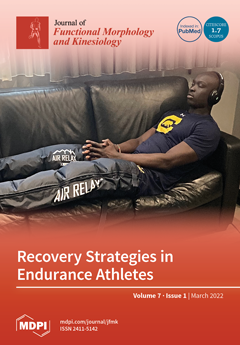In order to achieve optimal performance, endurance athletes need to implement a variety of recovery strategies that are specific to their training and competition. Recovery is a multidimensional process involving physiological, psychological, emotional, social, and behavioral aspects. The purpose of the study was
[...] Read more.
In order to achieve optimal performance, endurance athletes need to implement a variety of recovery strategies that are specific to their training and competition. Recovery is a multidimensional process involving physiological, psychological, emotional, social, and behavioral aspects. The purpose of the study was to examine current implementation, beliefs, and sources of information associated with recovery strategies in endurance athletes. Participants included 264 self-identified endurance athletes (male = 122, female = 139) across 11 different sports including placing top three overall in competition (
n = 55) and placing in the top three in their age group or division (
n = 113) during the past year. Endurance athletes in the current study preferred hydration, nutrition, sleep, and rest in terms of use, belief, and effectiveness of the recovery strategy. Female endurance athletes use more recovery strategies for training than males (
p = 0.043,
d = 0.25), but not in competition (
p = 0.137,
d = 0.19). For training, top three finishers overall (
p < 0.001,
d = 0.61) and by division (
p < 0.001,
d = 0.57), used more recovery strategies than those placing outside the top three. Similar findings were reported for competition in top three finishers overall (
p = 0.008,
d = 0.41) and by division (
p < 0.001,
d = 0.45). These athletes are relying on the people around them such as coaches (48.3%) and fellow athletes (47.5%) along with websites (32.7%) for information and recommendations. Endurance athletes should be educated on other strategies to address the multidimensionality of recovery. These findings will be useful for healthcare professionals, practitioners, and coaches in understanding recovery strategies with endurance athletes.
Full article






